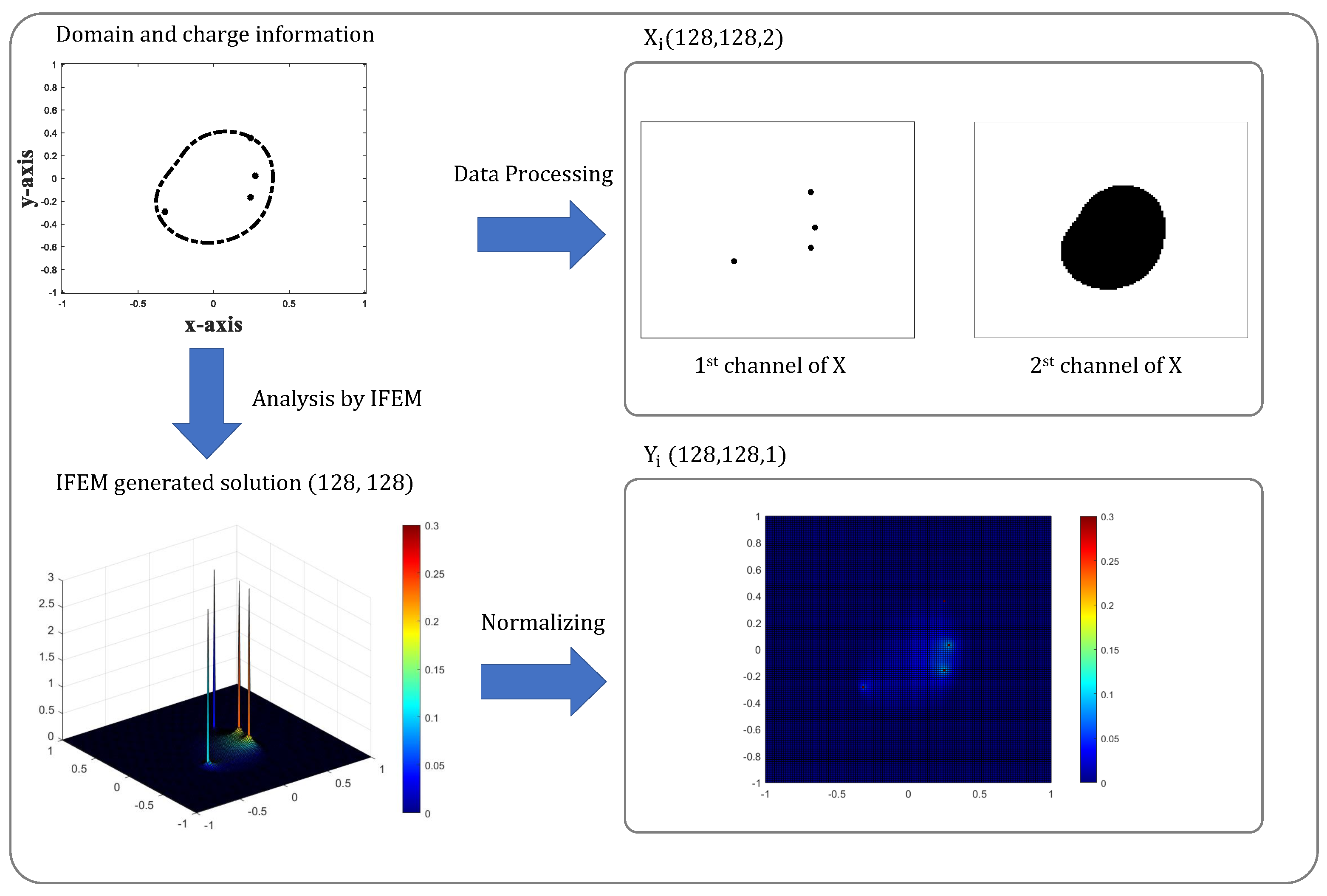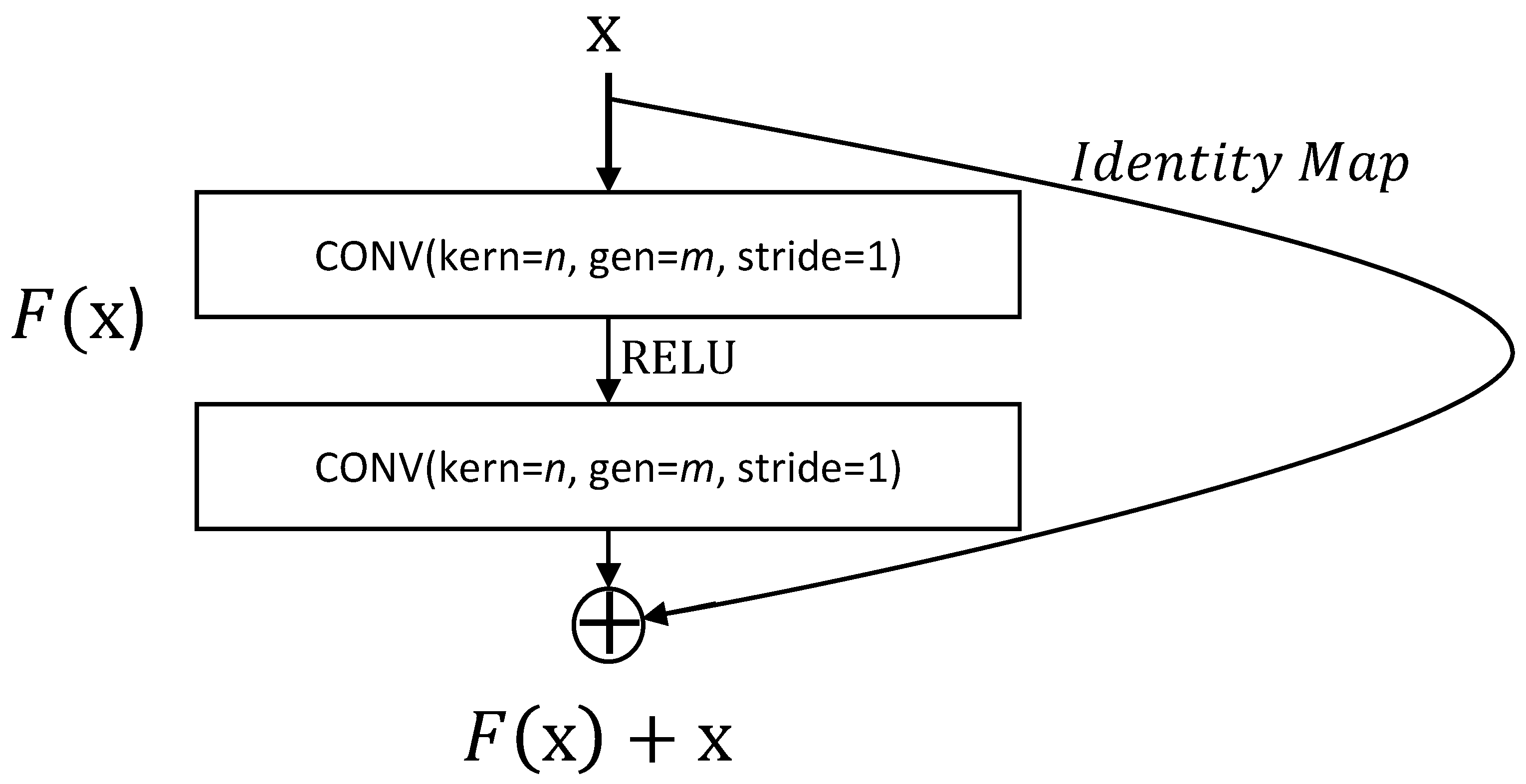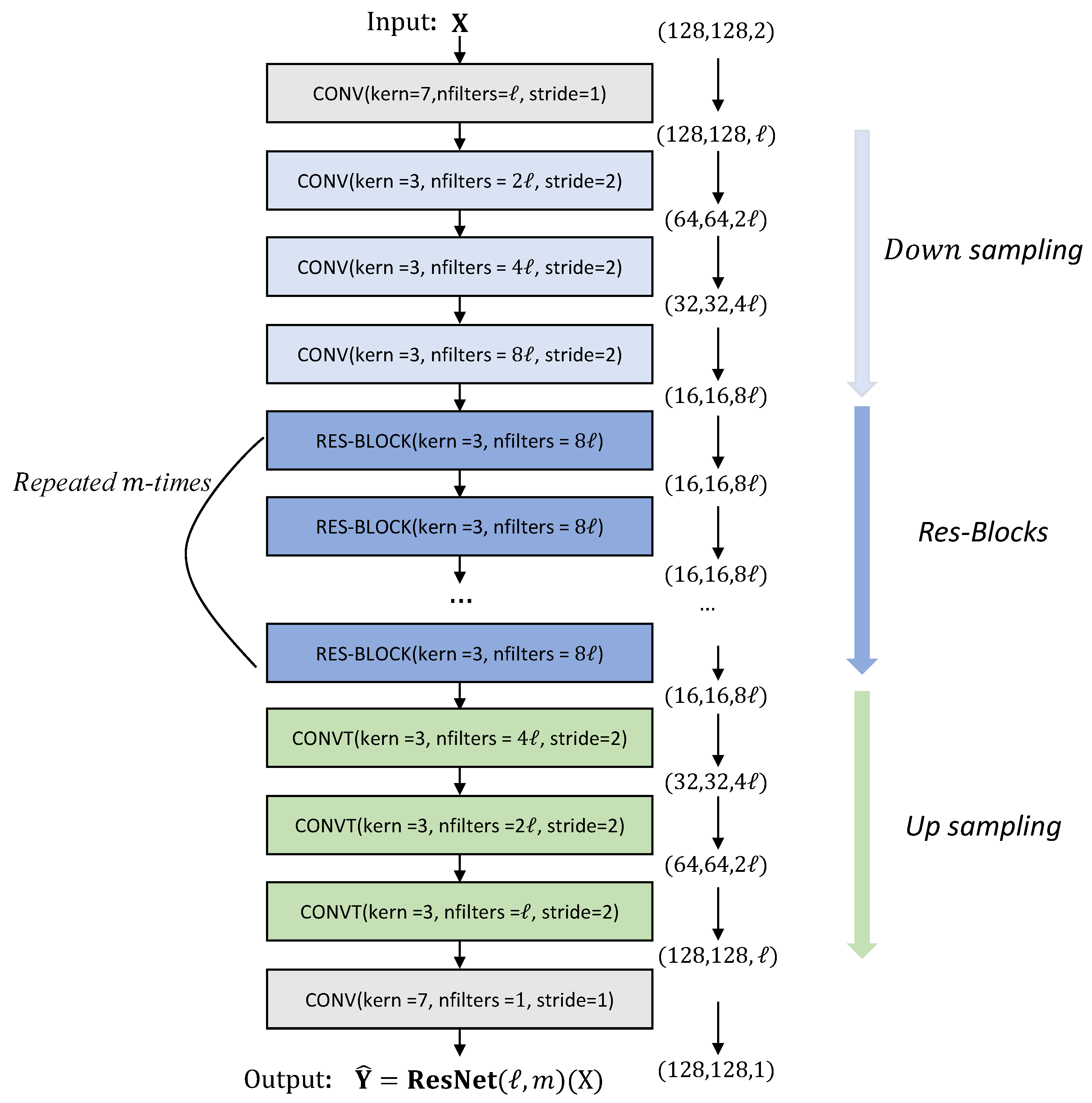A Deep Neural Network Based on ResNet for Predicting Solutions of Poisson–Boltzmann Equation
Abstract
:1. Introduction
2. Methods
2.1. Poisson–Boltzmann Equation and Regularization Process
2.2. Immersed Finite Element Method for Poisson–Boltzmann Equation
| Algorithm 1: IFEM. |
|
2.3. Formatting of Datasets and Data Preprocessing
2.4. ResNet Based Artificial Neural Network for Poisson–Boltzmann Equation
3. Results
4. Discussion and Conclusions
Author Contributions
Funding
Institutional Review Board Statement
Informed Consent Statement
Data Availability Statement
Conflicts of Interest
References
- Guoy, G. Constitution of the electric charge at the surface of an electrolyte. J. Phys. 1910, 9, 457–467. [Google Scholar]
- Chapman, D.L. A contribution to the theory of electrocapillarity. Lond. Edinb. Dublin Philos. Mag. J. Sci. 1913, 25, 475–481. [Google Scholar] [CrossRef] [Green Version]
- Derjaguin, B.; Landau, L. Theory of the stability of strongly charged lyophobic sols and the adhesion of strongly charged particles in solutions of electrolytes. Prog. Surf. Sci. 1993, 43, 30–59. [Google Scholar] [CrossRef]
- Verwey, E.J.W.; Overbeek, J.T.G.; Van Nes, K. Theory of the Stability of Lyophobic Colloids: The Interaction of Sol Particles having an Electric Double Layer; Elsevier Publishing Company: Amsterdam, The Netherlands, 1948. [Google Scholar]
- Davis, M.E.; McCammon, J.A. Electrostatics in biomolecular structure and dynamics. Chem. Rev. 1990, 90, 509–521. [Google Scholar] [CrossRef]
- Honig, B.; Nicholls, A. Classical electrostatics in biology and chemistry. Science 1995, 268, 1144–1149. [Google Scholar] [CrossRef] [PubMed] [Green Version]
- Chern, I.L.; Liu, J.G.; Wang, W.C. Accurate evaluation of electrostatics for macromolecules in solution. Methods Appl. Anal. 2003, 10, 309–328. [Google Scholar] [CrossRef]
- Chen, L.; Holst, M.J.; Xu, J. The finite element approximation of the nonlinear Poisson–Boltzmann equation. SIAM J. Numer. Anal. 2007, 45, 2298–2320. [Google Scholar] [CrossRef]
- Kwon, I.; Kwak, D.Y. Discontinuous bubble immersed finite element method for Poisson-Boltzmann equation. Commun. Comput. Phys. 2019, 25, 928–946. [Google Scholar] [CrossRef]
- Borleske, G.; Zhou, Y.C. Enriched gradient recovery for interface solutions of the Poisson-Boltzmann equation. J. Comput. Phys. 2020, 421, 109725. [Google Scholar] [CrossRef]
- Ramm, V.; Chaudhry, J.H.; Cooper, C.D. Efficient mesh refinement for the Poisson-Boltzmann equation with boundary elements. J. Comput. Chem. 2021, 42, 855–869. [Google Scholar] [CrossRef] [PubMed]
- Wang, S.; Alexov, E.; Zhao, S. On regularization of charge singularities in solving the Poisson-Boltzmann equation with a smooth solute-solvent boundary. Math. Biosci. Eng. 2021, 18, 1370–1405. [Google Scholar] [CrossRef] [PubMed]
- Kwon, I.; Kwak, D.Y.; Jo, G. Discontinuous bubble immersed finite element method for Poisson-Boltzmann-Nerst-Plank model. J. Comput. Phys. 2021, 438, 110370. [Google Scholar] [CrossRef]
- Shestakov, A.I.; Milovich, J.L.; Noy, A. Solution of the nonlinear Poisson-Boltzmann equation using pseudo-transient continuation and the finite element method. J. Colloid Interface Sci. 2002, 247, 62–79. [Google Scholar] [CrossRef]
- Lo, S.C.B.; Chan, H.P.; Lin, J.S.; Li, H.; Freedman, M.T.; Mun, S.K. Artificial convolution neural network for medical image pattern recognition. Neural Netw. 1995, 8, 1201–1214. [Google Scholar] [CrossRef]
- Szegedy, C.; Ioffe, S.; Vanhoucke, V.; Elemi, A.A. Inception-v4, inception-resnet and the impact of residual connections on learning. In Proceedings of the Thirty-First AAAI Conference on Artificial Intelligence, San Francisco, CA, USA, 4–9 February 2017. [Google Scholar]
- He, K.; Zhang, X.; Ren, S.; Sun, J. Deep residual learning for image recognition. In Proceedings of the IEEE Conference on Computer Vision and Pattern Recognition, Las Vegas, NV, USA, 27–30 June 2016; pp. 770–778. [Google Scholar]
- Devlin, J.; Chang, M.-W.; Lee, K.; Toutanova, K. Bert: Pre-training of deep bidirectional transformers for language understanding. arXiv 2018, arXiv:1810.04805. [Google Scholar]
- Brown, T.B.; Mann, B.; Ryder, N.; Subbiah, M.; Kaplan, J.; Dhariwal, P.; Neelakantan, A.; Shyam, P.; Sastry, G.; Askell, A.; et al. Language models are few-shot learners. arXiv 2020, arXiv:2005.14165. [Google Scholar]
- Deng, L.; Liu, Y. Deep Learning in Natural Language Processing; Springer: Berlin/Heidelberg, Germany, 2018. [Google Scholar]
- Purwins, H.; Li, B.; Virtanen, T.; Schlüter, J.; Chang, S.-Y.; Sainath, T. Deep learning for audio signal processing. IEEE J. Sel. Top. Signal Process. 2019, 13, 206–219. [Google Scholar] [CrossRef] [Green Version]
- Yu, D.; Deng, L. Deep learning and its applications to signal and information processing. IEEE Signal Process. Mag. 2010, 28, 145–154. [Google Scholar]
- Ngiam, J.; Khosla, A.; Kim, M.; Nam, J.; Lee, H.; Andrew, Y.N. Multimodal deep learning. ICML 2011. [Google Scholar]
- Tang, W.; Shan, T.; Dang, X.; Li, M.; Yang, F.; Xu, S.; Wu, J. Study on a Poisson’s equation solver based on deep learning technique. In Proceedings of the 2017 IEEE Electrical Design of Advanced Packaging and Systems Symposium, Haining, China, 14–16 December 2017. [Google Scholar]
- Antil, H.; Di, Z.W.; Khatri, R. Bilevel optimization, deep learning and fractional Laplacian regularization with applications in tomography. Inverse Probl. 2020, 36, 064001. [Google Scholar] [CrossRef] [Green Version]
- Chen, R.T.Q.; Rubanova, Y.; Bettencourt, J.; Duvenaud, D. Neural ordinary differential equations. arXiv 2018, arXiv:1806.07366. [Google Scholar]
- Ruthotto, L.; Haber, E. Deep neural networks motivated by partial differential equations. J. Math. Imaging Vis. 2020, 62, 352–364. [Google Scholar] [CrossRef] [Green Version]
- Kim, M.; Winovich, N.; Lin, G.; Jeong, W. Peri-Net: Analysis of Crack Patterns Using Deep Neural Networks. J. Peridynamics Nonlocal Model. 2019, 1, 131–142. [Google Scholar] [CrossRef] [Green Version]
- Haghighat, E.; Bekar, A.C.; Madenci, E.; Juanes, R. A nonlocal physics-informed deep learning framework using the peridynamic differential operator. Comput. Methods Appl. Mech. Eng. 2021, 385, 114012. [Google Scholar] [CrossRef]
- Kutz, J.N. Deep learning in fluid dynamics. J. Fluid Mech. 2017, 814, 1–4. [Google Scholar] [CrossRef] [Green Version]
- Liu, B.; Tang, J.; Huanga, H.; Lu, X.Y. Deep learning methods for super-resolution reconstruction of turbulent flows. Phys. Fluids 2020, 32, 025105. [Google Scholar] [CrossRef]
- Lu, B.; Zhou, Y.C.; Huber, G.A.; Bond, S.D.; Holst, M.J.; McCammon, J.A. Electrodiffusion: A continuum modeling framework for biomolecular systems with realistic spatiotemporal resolution. J. Chem. Phys. 2007, 127, 10B604. [Google Scholar] [CrossRef]
- Kwak, D.Y.; Jin, S.; Kyeong, D. A stabilized P1-nonconforming immersed finite element method for the interface elasticity problems. Esaim Math. Model. Numer. Anal. 2017, 51, 187–207. [Google Scholar] [CrossRef]
- Jo, G.; Kwak, D.Y. An IMPES scheme for a two-phase flow in heterogeneous porous media using a structured grid. Comput. Methods Appl. Mech. Eng. 2017, 317, 684–701. [Google Scholar] [CrossRef] [Green Version]
- Jo, G.; Kwak, D.Y. Recent development of immersed fem for elliptic and elastic interface problems. J. Korean Soc. Ind. Appl. Math. 2019, 23, 65–92. [Google Scholar]
- Jo, G.; Kwak, D.Y. A Reduced Crouzeix–Raviart Immersed Finite Element Method for Elasticity Problems with Interfaces. Comput. Methods Appl. Math. 2020, 20, 501–516. [Google Scholar] [CrossRef]
- Jo, G.; Kwak, D.Y.; Lee, Y.-J. Locally Conservative Immersed Finite Element Method for Elliptic Interface Problems. J. Sci. Comput. 2021, 87, 1–27. [Google Scholar] [CrossRef]
- Feng, W.; He, X.; Lin, Y.; Zhang, X. Immersed finite element method for interface problems with algebraic multigrid solver. Commun. Comput. Phys. 2014, 15, 1045–1067. [Google Scholar] [CrossRef]
- Jo, G.; Kwak, D.Y. Geometric multigrid algorithms for elliptic interface problems using structured grids. Numer. Algorithms 2019, 81, 211–235. [Google Scholar] [CrossRef]
- Kingma, D. P; Ba, J. Adam: A method for stochastic optimization. arXiv 2014, arXiv:1412.6980. [Google Scholar]
- Holst, M.J. Multilevel Methods for the Poisson-Boltzmann Equation. Ph.D. Thesis, Universitiy of Illinois at Urbana, Champaign, IL, USA, 1993. [Google Scholar]






| ResNet() | # Layers | # Kernels | # Parameters |
|---|---|---|---|
| (16, 10) | 28 | 2913 | 3,147,921 |
| (16, 20) | 48 | 5473 | 6,099,601 |
| (32, 10) | 28 | 5825 | 12,581,153 |
| (32, 20) | 48 | 10,945 | 24,382,753 |
| (64, 10) | 28 | 11,649 | 50,303,553 |
| (64, 20) | 48 | 21,889 | 97,499,713 |
| ResNet() | # Parameters | CPU time (s) | RMSE | MAE |
|---|---|---|---|---|
| (16, 10) | 3,147,921 | 2090 | 4.71 × 10−7 | 2.25 × 10−4 |
| (16, 20) | 6,099,601 | 2876 | 4.87 × 10−7 | 2.20 × 10−4 |
| (32, 10) | 12,581,153 | 3779 | 3.85 × 10−7 | 2.20 × 10−4 |
| (32, 20) | 24,382,753 | 5569 | 3.66 × 10−7 | 2.01 × 10−4 |
| (64, 10) | 50,303,553 | 8565 | 3.45 × 10−7 | 2.13 × 10−4 |
| (64, 20) | 97,499,713 | 13,264 | 3.81 × 10−7 | 2.07 × 10−4 |
Publisher’s Note: MDPI stays neutral with regard to jurisdictional claims in published maps and institutional affiliations. |
© 2021 by the authors. Licensee MDPI, Basel, Switzerland. This article is an open access article distributed under the terms and conditions of the Creative Commons Attribution (CC BY) license (https://creativecommons.org/licenses/by/4.0/).
Share and Cite
Kwon, I.; Jo, G.; Shin, K.-S. A Deep Neural Network Based on ResNet for Predicting Solutions of Poisson–Boltzmann Equation. Electronics 2021, 10, 2627. https://doi.org/10.3390/electronics10212627
Kwon I, Jo G, Shin K-S. A Deep Neural Network Based on ResNet for Predicting Solutions of Poisson–Boltzmann Equation. Electronics. 2021; 10(21):2627. https://doi.org/10.3390/electronics10212627
Chicago/Turabian StyleKwon, In, Gwanghyun Jo, and Kwang-Seong Shin. 2021. "A Deep Neural Network Based on ResNet for Predicting Solutions of Poisson–Boltzmann Equation" Electronics 10, no. 21: 2627. https://doi.org/10.3390/electronics10212627
APA StyleKwon, I., Jo, G., & Shin, K.-S. (2021). A Deep Neural Network Based on ResNet for Predicting Solutions of Poisson–Boltzmann Equation. Electronics, 10(21), 2627. https://doi.org/10.3390/electronics10212627






